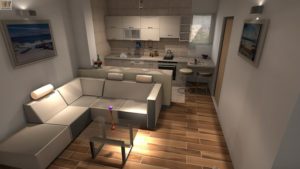 Screwing in a light bulb might be a simple task, but illuminating your entire [city] home is a completely different ballgame. When you ignore certain lighting rules and factors, you end up wasting electricity or have unsightly dark spaces—sometimes even both.
Screwing in a light bulb might be a simple task, but illuminating your entire [city] home is a completely different ballgame. When you ignore certain lighting rules and factors, you end up wasting electricity or have unsightly dark spaces—sometimes even both.
When lighting your [city] home with LED light bulbs, be sure to watch out for these 4 common mistakes people make when planning their home lighting scheme.
Choosing Light Fixtures in the Wrong Size
Failing to consider the size of a light fixture is perhaps the most common lighting mistake homeowners make. When you hang just one small pendant light over a large dining table, there simply isn’t enough illumination to cover the entire area. Conversely, hanging a large chandelier in the middle of a small room, or a huge lamp next to a reading chair, will produce too much light, and consequently, glare.
You need to match the size of your chandelier and lumen output of its light to the size of the room. A good rule of thumb is to add the width and height of your room in feet. This number can then be the diameter of a fixture like a chandelier, albeit in inches.
Using Just One Light Source
Another common mistake is to install just one light source in a room, which will almost always cover some areas in shadows. A single light source also does a poor job of lighting crucial working zones, such as stoves and food preparation areas in the kitchen.
With kitchen lighting, the key is to have balanced lighting. Ideally, the kitchen, as well as all other rooms of your house for that matter, should have three layers of lighting: ambient lighting, accent lighting, and task lighting. Together, these lights create a flattering illumination system.
Going Overboard with Recessed Lights
Many homeowners make the mistake of installing multiple recessed lights on their ceilings, thinking that’s all it takes to illuminate a room properly. However, recessed downlights don’t illuminate walls, which you’ll need to have balanced lighting. While recessed lights are important, you should complement their illumination with task lights such as lamps next to the sofa, pendant lights, and track lights among others.
Being Too Eager to Use Task Lights
Done right, task lights can be a beautiful addition to any home lighting system. Common applications include lights under the cupboard and sconces on either side of the mirror for a flattering view of your face. The key is not to go overboard, which will only give rooms a disjointed atmosphere.
A little bit of planning goes a long way to avoiding this problem. Think about the common tasks you’re going to do in the different rooms your home, and more importantly, where exactly in each room. If you’re going to do a lot of food prep in a certain spot on your kitchen counter, be sure to install lights near this area.
With home lighting, the trick to get the best possible setup is planning and matching. Choose fixtures that match your home’s current layout, don’t be afraid to use multiple light sources, and be prudent in the way you use your lights.

![4 Advantages LEDs Have Over CFLs [city]](https://eepros.com/wp-content/uploads/2017/04/pexels-photo-189333-300x200.jpeg)
![6 Common Pendant Light Shapes for Your [city] Home [city]](https://eepros.com/wp-content/uploads/2018/08/light-bulb-1407610_1280-300x169.jpg)
![5 Critical Lighting Elements Every Office Should Have [city]](https://eepros.com/wp-content/uploads/2019/03/chairs-2181960_640-300x200.jpg)
![Avoiding Mistakes When Upgrading to LED Lighting Systems [city]](https://8blocks.s3.amazonaws.com/eepros/blog-images/led-upgrade-mistakes.jpg)